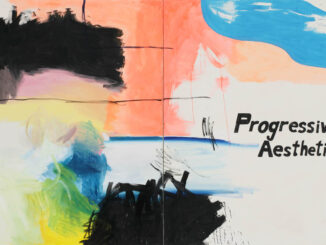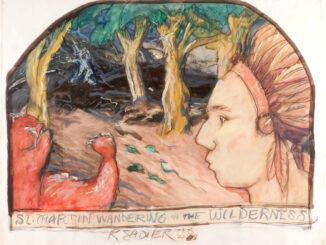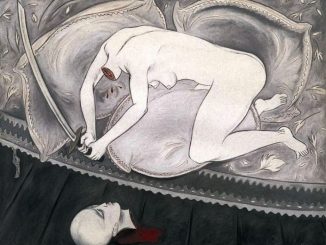 Leonard Tachmes has one of the coolest gallery spaces in town – three cozy rooms in an old house, with wooden floors and fireplace. That setting happens to be the perfect place to delve even more deeply into the world of interiors, through the large paintings hanging on those walls from one of the most talented painters in town, Jordan Massengale.
Leonard Tachmes has one of the coolest gallery spaces in town – three cozy rooms in an old house, with wooden floors and fireplace. That setting happens to be the perfect place to delve even more deeply into the world of interiors, through the large paintings hanging on those walls from one of the most talented painters in town, Jordan Massengale.
These brilliantly painted and brilliantly colored works explore inner spaces, both the physicality of them, and maybe more importantly, the life in them. Entitled Inside Out, the viewer is on the outside looking in. But after more than a cursory moment staring, it starts to feel as though you’ve entered them. The observer becomes part of the exploration of space and perspective that Massengale has mastered in his latest series, his second solo at Tachmes.
It’s a shame if you don’t give the paintings lots of time, to immerse yourself in these beautiful but also edgy works.
Massengale has a history of filling his canvases with quirky and violent imagery. There is no detectable violence in these new works, but the after-taste of something awry. Perspective, and therefore perception, is messed up. While the objects and detailed décor are very concrete as opposed to abstract, there is no way those objects could co-exist in real life the way they are drawn. As Massengale explains during an afternoon tour of the show, he is playing with the tension between the comfortable and uncomfortable, the predictable and unpredictable. It’s a tension that underneath relates to the people who occupy such rooms as much as among the inanimate objects themselves.
So how does Massengale tell his tales of interiors and the lives that create them? In the front room, the perspective of two paintings is actually from the inside looking out. In the most dramatic one, Snow Flurries, the view is of a naked women in the snow – very naked, shaved and totally sans pubic hair – giving a sassy and suggestive look back at us, who are likely warm and indoors. But this older and striking painting is not representative of the others, which are often empty of an actual human presence – just filled with the trappings of that presence.
These canvases are lush and chaotic in color, dense in detail, crowded, loud, and tightly packed. They are about textures and textiles; design and decor; and about the personal nature of perception.
The artist wants us to be participants in these scenes; when peering into the worlds, he may want us to think anew about our own. Like in Nothing to Watch, maybe superficially titled after the signal-less television in the middle of the room, except for us viewers, there is much to watch. On one side, there’s a multi-pronged 70’s-styled lamp with multi-colored glass lampshades.
Against the back wall, a zebra-skin screen. A tapestry hangs on a wall, which is painted buttery yellow next to a lime-green staircase, while brightly colored geometric tiles cover the floor and a glass ceiling reveals an outdoor landscape.
Then there are the weird angles and improbable placements, like the bookcase – is it standing against a wall, or just kind of floating in the room? The fan in the middle is so transparent as to appear ghostlike – it could not actually be where it is. In other words, at first glance it looks to be a hectic but somewhat realistic facsimile of a room. On closer inspection, it is anything but.
{mospagebreak}
The stunning Bachelor Pad is another space empty – mostly – of human form, and stuffed with stuff. There are a skateboard and dartboard and lava lamps, knotted-wood and plywood sidings, tiles of all different shapes and colors fighting for position on the floors and surfaces, and angles gone haywire – it’s masculinity colliding. Rooms jut into one another, wild decors aggressively clash. This pad of a single guy is vibrating, but there are only a few suggestions of living, breathing inhabitants. Massengale is interested in the aesthetics of spaces, but also “how we move through them.” Or, how we live our interior lives. There are signs here about how we do, you just have to register them.
Those familiar with Massengale’s work will be struck by the lack of human figures in these. In the past, he has packed his pieces with people and creatures, and has drawn some stunning profiles, including his skeletons series. But like his sometimes hyper-active painted scenes, Massengale doesn’t seem to like to sit artistically still.
What does stand out consistently in his work is his powerful execution. It comes as no surprise that Massengale describes his process as “painting with my body.” You can picture him throwing himself at these large canvases, moving with them – there is a real physicality about all of his work, past and present, although this series is less frenzied.
But some of Massengale’s strange creatures do re-emerge in Inside Out. In the crammed, darker Waiting Room, something disturbing is lurking. The tiny room is flooded with color, but it is richer – deep reds and greens, dark wooden furniture, subdued lamp-lighting – evocative of a salon early in the last century. A black-clad woman sits ram-rod straight and stares directly ahead, while a dummy puppet in an accompanying chair gives her a creepy look. In between them stands a creepy mask on an old radio set, hanging on the wall above, a creepy skull. And in the room behind, revealed by an open, velvet, pine-colored curtain, a school girl wearing knee-highs and a short, plaid skirt gazes in. This room is filled with tense human drama.
Sorority is lighter but still complicated, and way off kilter. The light and color are back to a Florida-like scheme – bright pinks, yellows, blues, purples. A couple of girls (or parts of them) and a cat are floating around this room, a monkey plays with a banana in a cage, some lamp-shades are let-loose and colliding with all of the above, a striped urn lays toppled on the super-busy tiled floor. There certainly is life in this sorority room, but a very fantastical and unstable one at that.
On the face of it, Space-Less Place is an oasis of calm on the last wall of the gallery; a black and white, ink on paper piece. Yet once again, if you let yourself jump in, it is as colorful, noisy, and kinetic as the others. Who lives in this bedroom? The zebra-skin carpet clashes directly with the flower-patterned bedspread, a toy car sits on the shelf, family pictures clutter the windowsill, and a funny drawing of two critters sits framed on the chair. We can take a pretty good guess as to the occupant of this space, although he is not physically there.
Inside Leonard Tachmes’ house, inside Jordan Massengale’s rooms, layers of lives are revealed, as are more basic concepts of how we literally view our space. The best revelation, however, is that the artist continues to be a powerful painter. Miami’s cultural space is richer for it.
By Anne Tschida







Be the first to comment